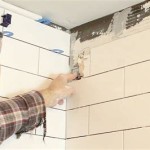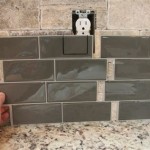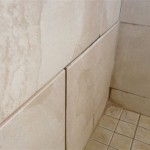What Is The Best Way To Remove Grout From Floor Tiles In Bathroom
Removing grout from bathroom floor tiles is a common task undertaken to refresh the look of a bathroom, repair damaged grout, or prepare for replacing tiles. This process requires careful execution to avoid damaging the tiles themselves and to ensure a clean and professional finish. The "best" method often depends on the type of grout, the tools available, and the homeowner's comfort level with DIY projects.
Grout deterioration is often manifested through cracking, crumbling, discoloration, and the growth of mold or mildew. These issues not only detract from the aesthetic appeal of the bathroom but can also lead to water damage if not addressed promptly. Water seeping beneath tiles can cause structural problems and create a breeding ground for harmful bacteria and mold.
Before embarking on the grout removal process, it's essential to gather all necessary materials and tools. This includes safety goggles, gloves, a grout saw, a utility knife with a grout removal attachment, a reciprocating saw with a grout removal blade (optional), a vacuum cleaner, a shop vacuum, a stiff-bristled brush, a grout removal solvent, a hammer, a chisel, and a sponge. The selection of tools will depend on the specific grout type and the severity of the damage.
Ensuring proper ventilation is paramount. Grout dust can be harmful if inhaled. Opening windows and using a fan to circulate air will help mitigate this risk. Protecting surrounding surfaces with drop cloths or plastic sheeting will also prevent accidental damage or staining.
Key Point 1: Assessing the Grout and Choosing the Right Tools
The first step in successful grout removal is a thorough assessment of the grout itself. Consider the type of grout (sanded or unsanded), its age, and the extent of the damage. Sanded grout is typically used for wider grout lines (1/8 inch or greater) and contains fine sand particles to prevent cracking. Unsanded grout, on the other hand, is used for narrower grout lines and is smoother in texture. Identifying the grout type will inform the appropriate tools and techniques to employ.
For relatively minor grout damage or narrow grout lines, a manual grout saw is often sufficient. These saws feature a hardened blade with an abrasive surface designed to grind away grout without damaging the surrounding tiles. When using a grout saw, apply consistent pressure and move it back and forth along the grout line. Avoid applying excessive force, as this can damage the tile edges.
A utility knife with a grout removal attachment offers another manual option. These attachments typically have a triangular or pointed shape that fits into the grout line. Similar to the grout saw, the utility knife is used to scrape away the grout. Care must be taken to maintain a steady hand and avoid slipping, which could scratch the tile surface.
For more extensive grout damage or wider grout lines, a reciprocating saw with a grout removal blade can be a more efficient option. These power tools vibrate the blade rapidly, allowing for faster grout removal. However, reciprocating saws require a higher degree of control and precision to prevent tile damage. It is recommended to practice using the saw on a test area before tackling the main bathroom floor.
In situations where the grout is particularly hard or stubborn, a hammer and chisel may be necessary. This method requires extreme caution, as it carries a higher risk of tile damage. The chisel should be held at a shallow angle and tapped gently with the hammer. Work slowly and methodically, removing small pieces of grout at a time.
Regardless of the chosen tool, it's advisable to wear safety goggles to protect the eyes from flying debris. Gloves will also protect the hands from abrasion and potential exposure to chemicals.
Key Point 2: Utilizing Grout Softening Techniques
Before attempting to remove grout, softening it can significantly ease the process and reduce the risk of tile damage. Several methods can be employed to soften grout, including using grout removal solvents, applying heat, or utilizing steam.
Grout removal solvents are chemical solutions designed to break down the grout's composition, making it easier to scrape or cut away. These solvents are available at most hardware stores and home improvement centers. It's crucial to carefully read and follow the manufacturer's instructions when using these products. Ensure adequate ventilation and wear appropriate protective gear, such as gloves and eye protection.
The typical application procedure involves applying the solvent liberally to the grout lines and allowing it to dwell for the recommended time period, usually 15-30 minutes. The solvent will penetrate the grout, weakening its structure and making it more pliable. After the dwell time, the grout can be removed using the chosen tool.
Heat is another effective method for softening grout. A heat gun or hairdryer can be used to apply heat directly to the grout lines. The heat will cause the grout to expand and soften, making it easier to remove. Avoid overheating the tiles, as this could cause them to crack. Move the heat source slowly and evenly across the grout lines.
Steam cleaners offer a more environmentally friendly alternative to chemical solvents. The hot steam penetrates the grout, loosening it without the use of harsh chemicals. Steam cleaners are particularly effective for removing mold and mildew from grout lines. Direct the steam nozzle along the grout lines, allowing the steam to penetrate the grout before attempting to remove it.
After applying any softening method, it's essential to thoroughly clean the area before proceeding with grout removal. This will remove any residue or debris that could interfere with the removal process.
Key Point 3: The Grout Removal Process and Cleanup
Once the grout has been softened and the appropriate tools have been selected, the actual removal process can begin. The key to successful grout removal is patience and precision. Working too quickly or applying excessive force can easily damage the surrounding tiles.
If using a manual grout saw or utility knife, hold the tool at a slight angle and apply consistent pressure as you move it along the grout line. Avoid pressing too hard, as this can cause the tool to slip and scratch the tile surface. Work in short, controlled strokes, gradually removing the grout. Periodically clean the grout line with a brush to remove debris and ensure that you are removing all of the grout.
When using a reciprocating saw, start with a low speed and gradually increase it as you become more comfortable. Hold the saw firmly and guide it along the grout line, allowing the blade to do the work. Avoid pressing down too hard, as this could cause the blade to jump or skip, potentially damaging the tiles. Overlapping passes may be necessary to completely remove the grout.
If using a hammer and chisel, hold the chisel at a shallow angle and tap it gently with the hammer. Work slowly and methodically, removing small pieces of grout at a time. Avoid striking the chisel too hard, as this could crack the tiles. Take frequent breaks to assess your progress and ensure that you are not damaging the surrounding tiles.
After removing the bulk of the grout, use a small brush or vacuum cleaner to remove any remaining debris. A shop vacuum is particularly useful for this purpose, as it can handle fine dust and debris. Inspect the grout lines carefully to ensure that all of the old grout has been removed.
Finally, thoroughly clean the tiles and grout lines with a damp sponge to remove any remaining residue. A mild detergent can be used to help clean the tiles. Allow the area to dry completely before applying new grout. The cleaning process is crucial to create a bonding surface for the new grout.
The selection of new grout is just as important as the removal process. Select a high-quality grout that is appropriate for the type of tile and the width of the grout lines. Consider factors such as color, stain resistance, and water repellency. Properly installed new grout will not only enhance the appearance of the bathroom but will also protect the underlying substrate from water damage.
By carefully assessing the grout, choosing the right tools, utilizing grout softening techniques, and executing the removal process with patience and precision, homeowners can successfully remove grout from bathroom floor tiles and prepare the surface for new grout or tile installation.

How To Remove And Replace Grout In A Shower Diy For Beginners

How To Clean Grout Tile Cleaning Tips Simply Spotless

How To Clean Tile Floors The Home Depot

How To Clean Tile Floors

How To Get Rid Of Leftover Grout Haze Quickly And Easily The Creek Line House

Commercial Restroom Tile Grout Floor Cleaning Tips Building Services

How To Clean Bathroom Tile And Grout Reviews By Wirecutter

How To Clean Tile Grout With Homemade Solutions

The Ultimate Guide To Cleaning Grout Floors Tile Showers Natural Stone

How We Got Our Stained Grout White Again Young House Love
Related Posts








